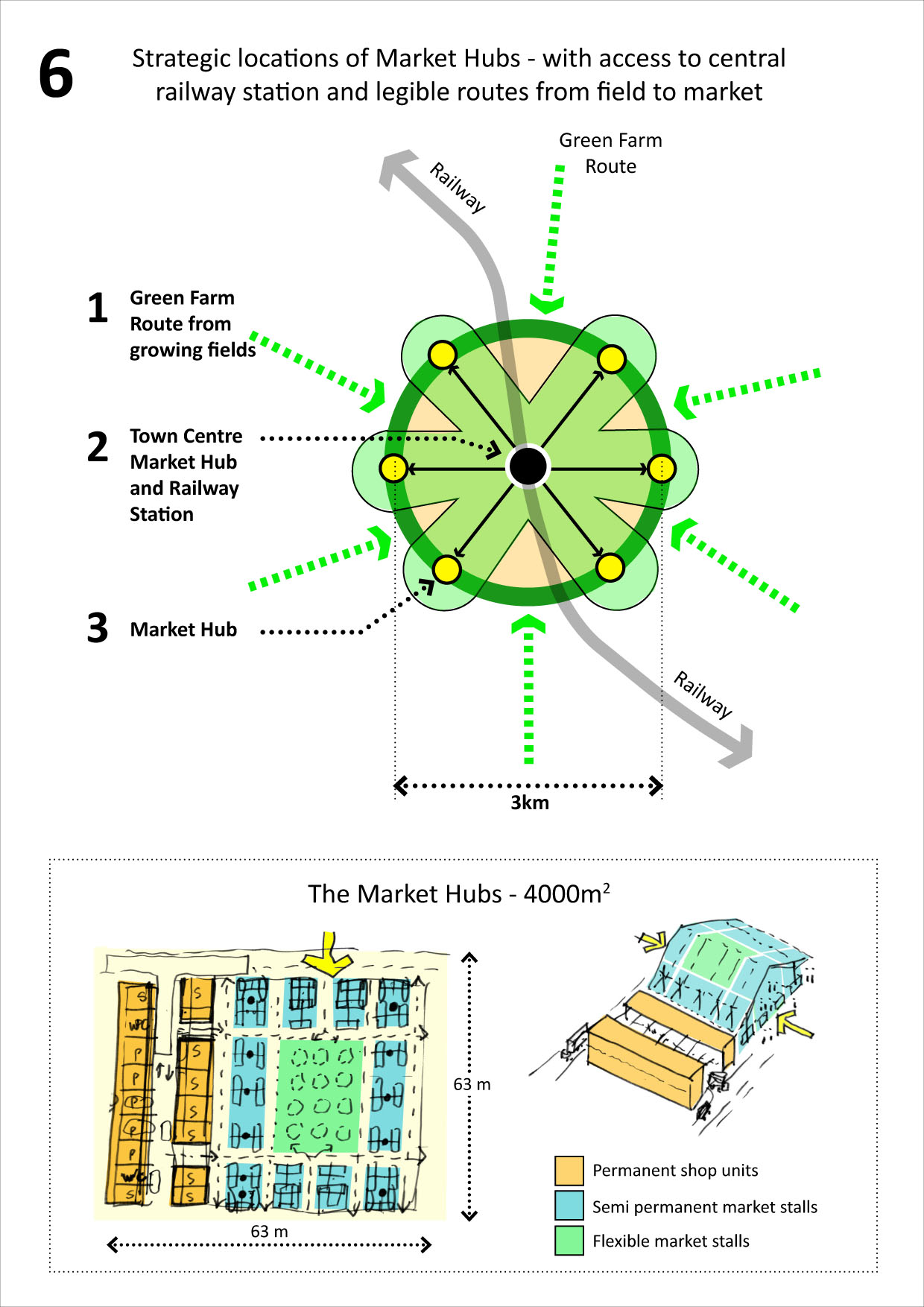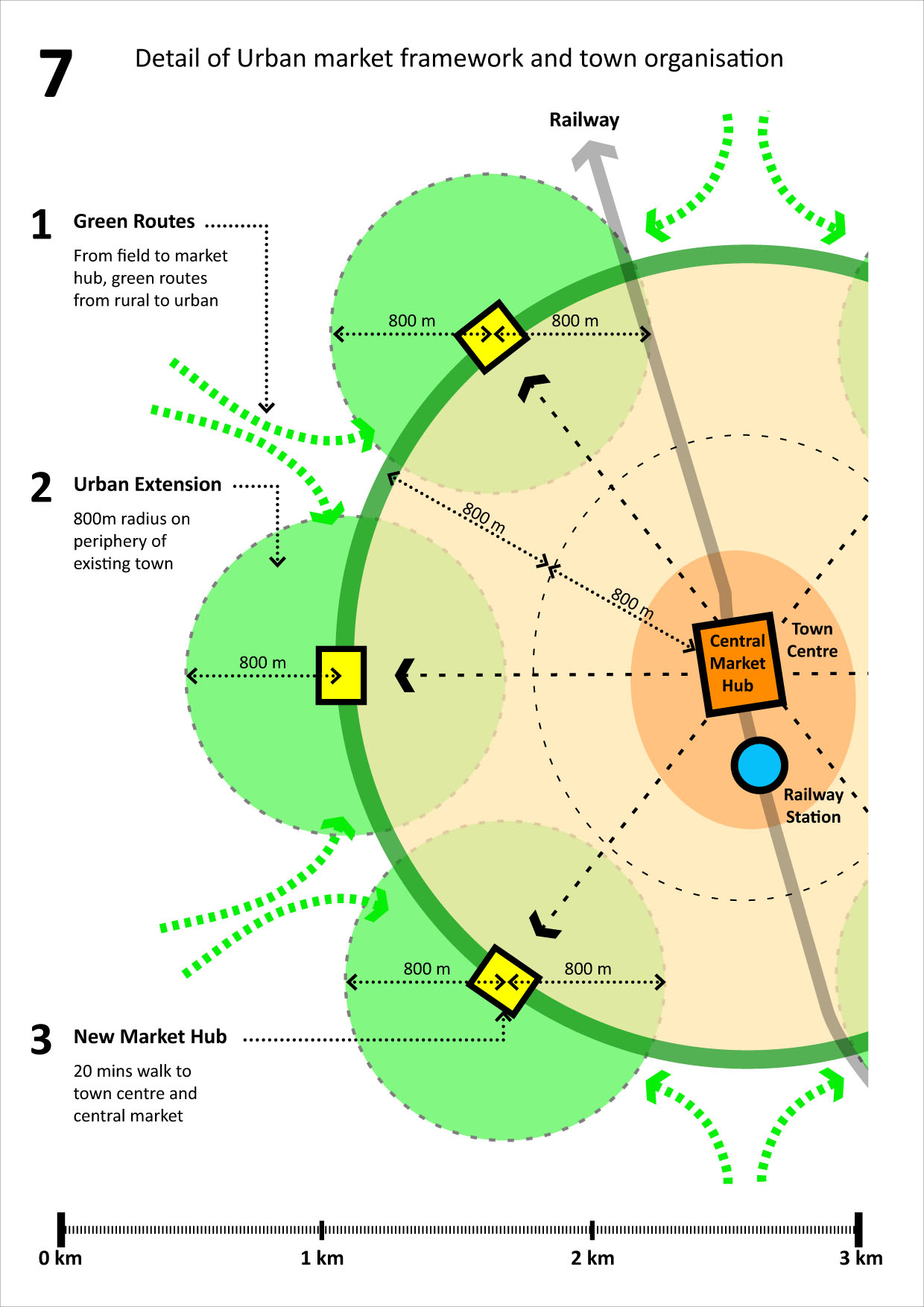Market Garden City
What is Market Garden City?
Market Garden City is an emerging planning concept from the 2014 Wolfson Prize Essay by Gary Young & Hannah Smart.
"Our Wolfson essay argued that both historic towns and new towns have evolved over time to become staunch guardians of their inherited and imperfect gardens and green belts. This has become the accepted status quo without understanding the loss of real 'market gardens' which could produce food locally, giving access to open space and sustaining the community".
The essay title stems from the practice of market gardening, a common and essential balance of rural and urban living until the mid 20th century. Local growers provided fresh food delivered daily to markets in towns or cities feeding the local urban population. Market Garden City is a planning concept put forward by landscape architects and urban designers to illustrate how this balance could be recreated as a new type of 21st Century garden city. The concept creates a plan from the small scale and specific to the universal, providing a role at the beginning for either individuals or small group.
The plan describes how the measurement of space available to grow food can be correlated to a potential for calories and hence a daily supply of nutrition. Starting from an understanding of how an individual could effectively grow a percentage of their own food, the plan would then support and develop skills to up-scale to a larger self-sufficient community using, food-share hubs, knowledge-share, innovative food growing technologies and delivery. The spatial plan would ensure sufficient open space, building surfaces or interiors and distribution hubs are available fro growing food to meet demand locally, expanding from this group capability towards an entirely sustainable local population.
"Where an individual could start one day with an area of just 1m2 to supply food and sustain themselves for the equivalent of 1 day, then, over time, learn to grow the idea collectively at local level to achieve sustainable food for themselves and others over 365 days a year".
Has this approach been considered before and why is it especially relevant today?
The Market Garden City has existed before, where localised food production has enabled cities to prosper and survive for centuries before globalisation, yet its importance has been forgotten during the 20th century. This is not because the Market Garden City is impossible to achieve, rather because local food production for local people has not been seen as a long term investment, has not been valued highly enough, or given incentives to compete with alternative global economies. The scientific facts demonstrating human impact on the planet are clear and require urgent action. Continuing irreversible environmental damage, "the do nothing scenario" and hoping for unproven planet scale technical fixes is not a plausible alternative. The consequences of inaction are no longer just science fiction.
In addition to man made climate change, a wide mixture of global trends affecting food self-sufficiency: historic patterns of capital and land ownership, trade tariffs, depletion of natural resources, increasing prosperity for some and poverty for others. Rapid changes and efficiency gains have convinced that large scale agricultural practice and global transportation are better than local, however these methods are heavily dependent on fossil fuels.
Food supply is affected by a growing population with economic pressure to leave rural areas resulting in the need to spend more time commuting longer distances to work in urban areas. Combined with the demand generated by media for luxury foods, this has resulted in widespread consumption of prepackaged and non seasonal food. Together with lack of available land this has culminated in communities and businesses being unwilling, deskilled or not able to afford time or money to select or provide food from local sources for self-sufficiency.
We require the land area equivalent to three times our planet earth through human exploitation of earths resources beyond sustainable levels. This includes food production and lifestyle and is adversely affecting all species. However, a growing number of champions are protecting the environment, understanding the science and advocating ethical choices. There is hope that young people could be leaders of a sustainable future. This momentum inspired our publication of Market Garden City, providing a reasoned planning approach to support food grown locally.







Does Market Garden City have a wide application or is it just relevant to the UK ?
The Market Garden City concept started by understanding the UKs specific food growing conditions and a recent history of market gardens. The concept of sustainable food growing would be adaptable more widely with proper consideration of local soil, climate, external or internal space available, local economies and food growing opportunities. Each approach would then create benchmarks from the calories required for a population to be generated from food produced in the available local areas. Taking into account the specific local conditions, monitoring the food produced, the plan would balance the available areas and demonstrate needs for further progress towards sustainability. The local spatial plan would demonstrate how food production would be integrated within and around villages, towns and cities.
There are positive conclusions from Market Garden City. Sufficient amounts of good quality land could be available. The awareness and value of local food is growing. Incremental plans could be scaled up to build cohesion. A growing web based community can provide real information on why, how and what can be done. The instincts of a sociable population can influence and direct to such an extent that vast untapped community resources makes local food production a reality.
A "Market garden city....without limits: the truly green ecumenopolis".
This concept has potential, it is not science fiction, it would sustain an entire planet, providing local food for all its species, human, flora and fauna.
How can Market Garden City concept begin to influence individuals and communities?
The Market Garden City concept demonstrates how the daily amount of calories required by a typically active person can have a spatial dimension established from reviewed metrics to estimate the area needed to grow a range of foods for sustenance. The examples show the amount of space required for food one day or a year for a range of produce, predominantly vegetable and fruit with some eggs and dairy. For example in the UK potatoes are the most effective food grown to create maximum calories from minimum space, however will need more variety to provide a suitable mixed diet. Although meat as a food source has higher calorific return per kg, it is not considered in this concept for two reasons: the areas required would be between 10 to 30 times the examples shown, exceeding areas which are viable for the concept. Equally, the Market Garden City concept aims to promote small scale local horticulture for self sufficiency, which is the opposite of large scale agriculture, and emphasises how scaling up from an individual to a whole community is feasible and desirable.
Illustrations from Market Garden City explaining some detail of the idea:
Minimum = 365m 2 per person
(equal to 1m 2 per day of each year). This would consist of a diet providing maximum food energy from potatoes with little variation.
Standard = 730m 2 per person
(equal to 2m 2 per day of each year). This would consist of a diet on mainly potatoes with some veg etable and fruit variation.
Variety = 1095m 2 per person
(equal to 3m 2 per day of each year). With a diet consisting of potatoes with some vegetables, fruit, dairy and eggs .



